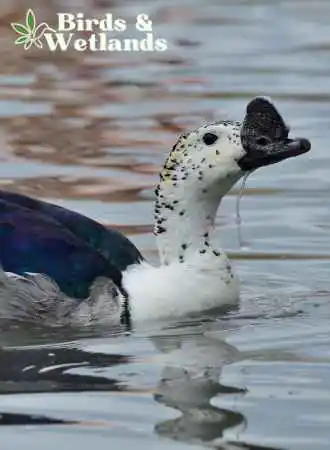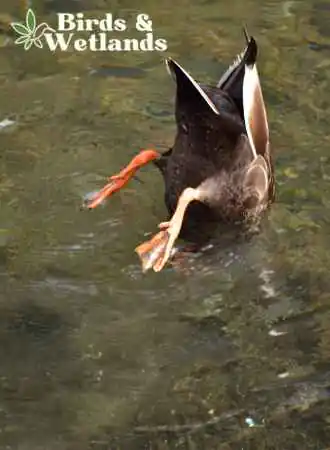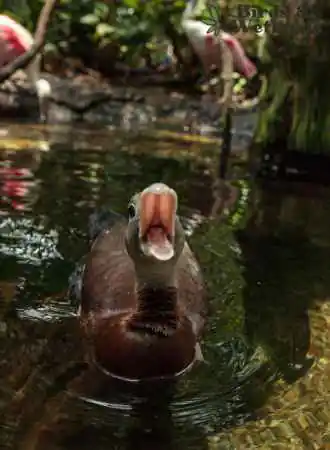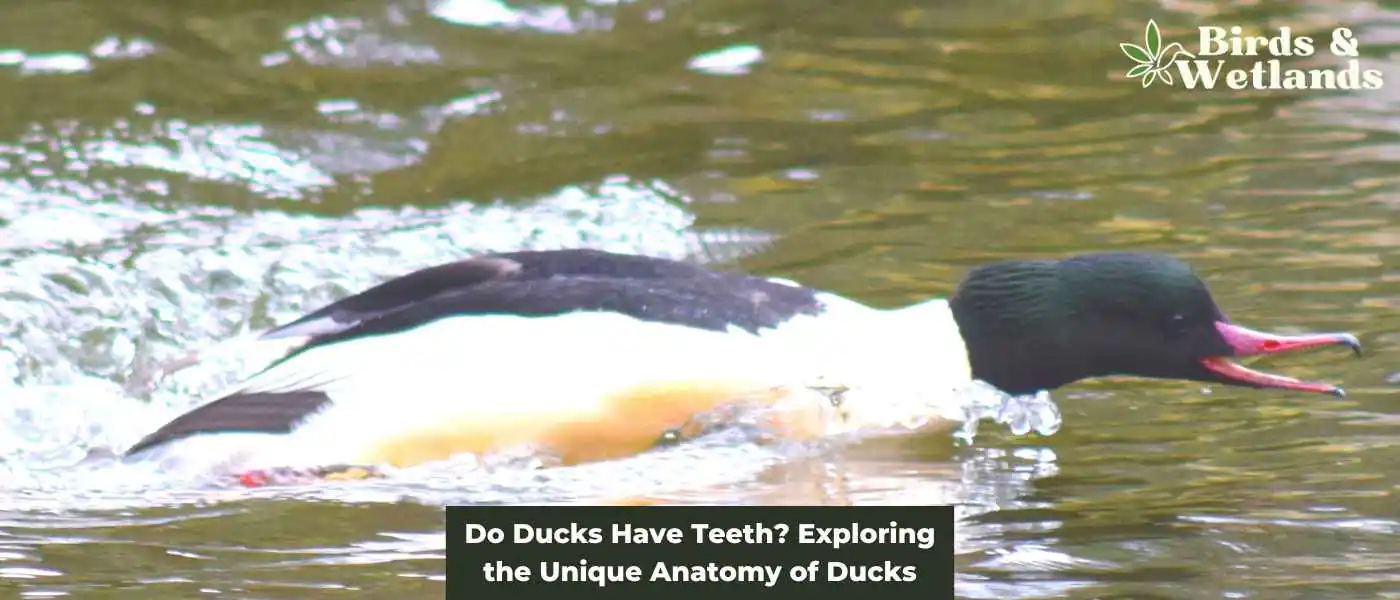Ducks are fascinating creatures with unique physical adaptations that allow them to thrive in their environment. One of the most interesting questions about ducks is whether or not they have teeth.
While many animals have teeth to help them break down food, ducks have evolved a different strategy to help them eat.
Do ducks have teeth?
Ducks do not have teeth in the traditional sense like mammals. Instead, they have serrated edges called “tomia” on their bills. These comb-like structures help them filter and grip their food, allowing them to effectively consume a variety of aquatic plants, insects, and small fish.
Key takeaways
- Forget teeth: ducks sport unique “tomia” on their bills
- Serrated edges allow for effective filtering and gripping of food
- Tomia support ducks’ diverse diet, from aquatic plants to small fish
Do Ducks Have Teeth?

Ducks are fascinating birds that can be found all over the world. One of the questions that people often ask about ducks about duck teeth. The answer to this question is not a straightforward one. While ducks don’t have teeth in the traditional sense, they do have several adaptations and specialized bill structures that help them manipulate their food and eat more easily.
The Anatomy of a Duck’s Bill
To understand how ducks eat, it’s important to first take a closer look at the anatomy of their bills. A duck’s bill is made up of two sections: the upper and lower mandibles. These mandibles are covered in a thin layer of skin that is filled with tiny projections called “lamellae.” These lamellae act like filters, allowing the duck to sift through water or mud to find food.
The Function of a Duck’s Bill

Ducks use their bills for a variety of functions, including feeding, preening, and even fighting. When it comes to feeding, ducks use their bills to scoop up food from the water or mud. They then use their tongues to move the food to the back of their bills, where it is crushed and ground up by the lamellae. This allows the duck to extract as much nutrition as possible from its food before swallowing.
While ducks don’t have teeth, some species of ducks, such as the Northern Shoveler, have specialized bills that are lined with small, comb-like structures that help them filter out small aquatic organisms. Other species, like the Mallard, have bills that are designed for dabbling in shallow water and feeding on plants and small invertebrates.
While ducks don’t have teeth in the traditional sense, they do have several adaptations and specialized bill structures that help them manipulate their food and eat more easily. Understanding the anatomy and function of a duck’s bill can give us a greater appreciation for these amazing birds.
What Do Ducks Eat?
Ducks are omnivores and have a varied diet that is strongly influenced by what food is available in their aquatic habitats. They consume all manner of pondweed and aquatic plants as well as insects, mollusks, fish eggs, and even small crustaceans, fish, and amphibians such as frogs.
A Varied Diet

Wild ducks have a diverse diet that depends on their species, habitat, and season, we have a full guide to feeding ducks. Some ducks are dabblers, meaning they feed on the surface of the water by tipping their heads down and straining food from the water. Others are diving ducks, which dive underwater to catch small fish and other foods.
Dabbling Ducks
Dabbling ducks feed on a variety of plant material, including aquatic plants, seeds, and grains. They also consume insects, snails, and other small invertebrates. Some common dabbling ducks include mallards, teal, and wood ducks.
Diving Ducks

Diving ducks feed on small fish, aquatic invertebrates, and other underwater vegetation. They have evolved specialized bills that help them catch and hold onto their prey. Some common diving ducks include canvasbacks, scaups, and goldeneyes.
Wild ducks have a varied diet that includes a wide range of foods, from plant material to small fish and invertebrates. Their specific diet depends on their species, habitat, and season.
How Do Ducks Eat?
Ducks have a unique way of eating that is different from most animals. They do not have teeth like humans do, but they have special adaptations in their beaks that help them eat. In this section, we will explore how ducks eat and the different processes involved.
Biting and Grinding

Ducks do not have teeth, but they have a beak that is strong and can bite through tough materials. The beak is made of keratin, which is the same material that makes up human hair and nails. The beak is also shaped to help ducks break down food. Ducks have a serrated edge on their beaks that looks like teeth. This edge helps them grip and tear apart food.
Ducks also have a comb-like structure on the inside of their beaks called lamellae. These structures help ducks filter food from water and also help them grind food. When ducks eat, they use their beaks to grab and tear apart food, and then use their lamellae to grind it up into smaller pieces.
Chewing and Swallowing
After the food has been ground up, ducks swallow it whole. Unlike humans, ducks do not chew their food. Instead, they have a gizzard, which is a muscular organ that helps break down food further. The gizzard is located near the stomach and contains small rocks and grit that help grind up food even more.
Once the food is broken down into small enough pieces, it passes through the gizzard and into the stomach. From there, the food is digested and nutrients are absorbed into the body.
Ducks do not have teeth like humans, but they have special adaptations in their beaks and digestive system that help them eat. Ducks use their beaks to bite and tear apart food, and then use their lamellae to grind it up. They do not chew their food, but instead rely on their gizzard to break it down further.
Interesting Features of a Duck’s Bill
Ducks are fascinating birds with unique bills compared to other bird species that have evolved to help them find and consume their food. Here are some interesting features of a duck’s bill:
Lamellae
One of the most distinctive features of a duck’s bill is the presence of lamellae. These are small, comb-like structures that line the inside of the bill and help the duck filter food from the water. When a duck dips its bill into the water, it opens its mouth slightly, allowing water and food to enter. The duck then closes its bill and pushes the water out through the lamellae, trapping the food inside.
Serrated and Flatter Bills

Ducks have bills that are adapted to the type of food they eat. Some ducks, like the merganser, have bills with serrated edges that help them catch and hold onto fish. Other ducks, like the mallard, have flatter bills that are better suited for grazing on vegetation.
Grin Patch
Another interesting feature of a duck’s bill is the presence of a “grin patch.” This is a small, rough patch of skin on the side of the bill that helps the duck grip slippery food like fish. When a duck catches a fish, it uses its bill to hold onto it while it repositions the fish in its mouth for swallowing.
A duck’s bill is a remarkable adaptation that allows it to find and consume its food in a variety of environments. The presence of lamellae, sharper bills, flatter bills, and grin patches are just a few of the interesting features that make a duck’s bill unique.
FAQS on Duck Teeth
Do ducks have teeth?
Ducks don’t have teeth like humans or other animals, but they do have interesting features called lamellae in their bills. These comb-like structures can look like serrated teeth and are used to help ducks eat.
How many teeth does ducks have?
As mentioned earlier, ducks don’t have actual teeth. Instead, they have teeth-like structures, the lamellae, which line the edges of their ducks beaks. The number of lamellae may vary among duck species.
What are duck teeth for?
Duck teeth, or more accurately, the duck’s lamellae, help ducks eat. These comb-like structures enable ducks to strain food from water, mud, or ground. Ducks use their bills to filter out plant material, small fish, insects, and other foods while keeping the unwanted material out of their mouths.
Do ducks have serrated teeth?
Ducks have serrated teeth-like structures called lamellae in their bills. These lamellae help ducks strain food, such as aquatic plants and small fish, from water and mud.
Are ducks teeth sharp?
The lamellae in a duck’s bill may look like serrated teeth, but they are not sharp like the teeth of other animals. Different species of ducks have bills with different shapes and edges, with some ducks having flatter bills and others having sharper bills.
How do ducks eat if they don’t have teeth?
Although ducks don’t have teeth, they can still eat thanks to the unique features of their bills. Ducks use their duck bills, especially the lamellae, to strain food from water, mud, or the ground. They don’t chew their food like mammals do; instead, they swallow their food whole. The duck’s digestive system, including the gizzard, then helps grind food down for digestion.
Do ducks have tongues?
Yes, ducks have tongues that help them manipulate food inside a duck’s mouth. The tongue works in tandem with the lamellae in the duck bill to strain and swallow food, allowing the duck to consume a varied diet of plant matter, insects, small fish, and other foods.
Can Ducks Bite?
Yes, ducks can bite. Although ducks don’t have teeth like other animals, they can still use their bills to deliver a pinch or bite if they feel threatened or scared. Duck bites may not be as painful or dangerous as the bite of other animals, but a duck bite can still be uncomfortable.
It is essential to treat wild ducks with respect and avoid getting too close or handling them, as this can stress them out and provoke a bite, especially female ducks if you get close to their eggs or ducklings – just like many other birds especially geese!
Can Ducks Chew Their Food?
Ducks do not chew their food in the same way that mammals do, as they don’t have teeth. Instead, ducks use their bills and the lamellae within to strain food from water, mud, or the ground. They swallow their food whole, without chewing it first. Once swallowed, the food goes through the duck’s digestive system, where the gizzard, a specialized muscular organ, helps to grind the food for further digestion.


